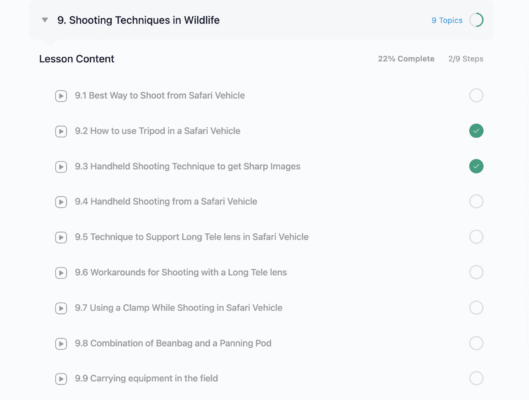Forum Replies Created
-
Offline viewing of courses / download option is not available.
-
I just checked and it’s loading fine. It sometimes happens due to buffering issue. Please try again after sometime.
-
Sudhir Shivaram
AdministratorJuly 8, 2025 at 12:39 pm in reply to: D850 or Z7ii – which one should i prefer ?In the current era, better to go with Mirrorless camera. Since you do not have Nikon lens, it is as good as getting a new camera and lens. If it is wildlife, you should go for Sony. Sony A7 IV and Sony 200-600.
-
This reply was modified 5 months, 1 week ago by
 Sudhir Shivaram.
Sudhir Shivaram.
-
This reply was modified 5 months, 1 week ago by
-
Dear Harish,
We do not have any flash photography course. But if you want to improve your photography then you need to get your fundamentals right. And also master the art of post processing. All these are there in the all-in-one course which you should subscribe.
The most important thing is to get the correct camera settings, basically the exposure, white balance, metering with exposure compensation and finally focusing. Once you master all these, you need to work on composition and finally post processing.
Rgds,
Sudhir -
I would highly encourage you to get the Z lens rather than using an adapter. The 180-600 is a good lens.
-
Sudhir Shivaram
AdministratorJuly 8, 2025 at 12:34 pm in reply to: How to measure focal length being usedFor telephoto fixed focal lens – You directly see what lens you are using. If it’s a 400mm f/2.8 lens, then focal length is 400mm. If it’s a zoom lens, then exif information in the image viewer will tell you.
-
No issues. Most of the Canon DSLR menu is almost the same. You can refer the Canon 5D Mark IV course for your model.
-
Absolutely no issues.
-
Sudhir Shivaram
AdministratorJuly 6, 2025 at 11:18 am in reply to: Query about custom white balanceNope. That will not work. The whole purpose of custom white balance is to get a reference of white in that lighting situation. Depending on what WB you have kept the camera will calculate the values of that white paper in that lighting situation and give you a proper wb.
What you are proposing is to simply overexpose the scene you are shooting and that will not work. -
Hope you have subscribed to my course. That’s the best way to start learning.
-
Hi Kiran, We do have a course on Photoshop here. Not sure how you missed it.
https://learn.sudhirshivaramphotography.com/courses/post-processing-using-adobe-camera-raw-and-photoshop/I have stopped using PS and now do my entire processing on LRC.
-
Just follow the tips I have shared in both wildlife course and the bird photography course. That should do.
-
Sudhir Shivaram
AdministratorJune 29, 2025 at 4:15 am in reply to: Tripod or Monopod for board photography and wildlife photographyDear Krishna,
I have an entire chapter for this specific topic in the wildlife course:
https://learn.sudhirshivaramphotography.com/courses/wildlife-photography/ -
Sudhir Shivaram
AdministratorJune 27, 2025 at 4:34 am in reply to: Nikon D850 or Z7ii – which is better for wildlifeSince you will have to buy the Nikon lenses as well, why don’t you consider Sony mirrorless and corresponding lens? For wildlife, nothing better than a Sony.
-
I do not see anything wrong in the photo. Looks good. If you are watching on phone, then depends on the screen display of the phone.
-
This reply was modified 5 months, 1 week ago by
 Sudhir Shivaram.
Sudhir Shivaram.
-
This reply was modified 5 months, 1 week ago by



Social Networks